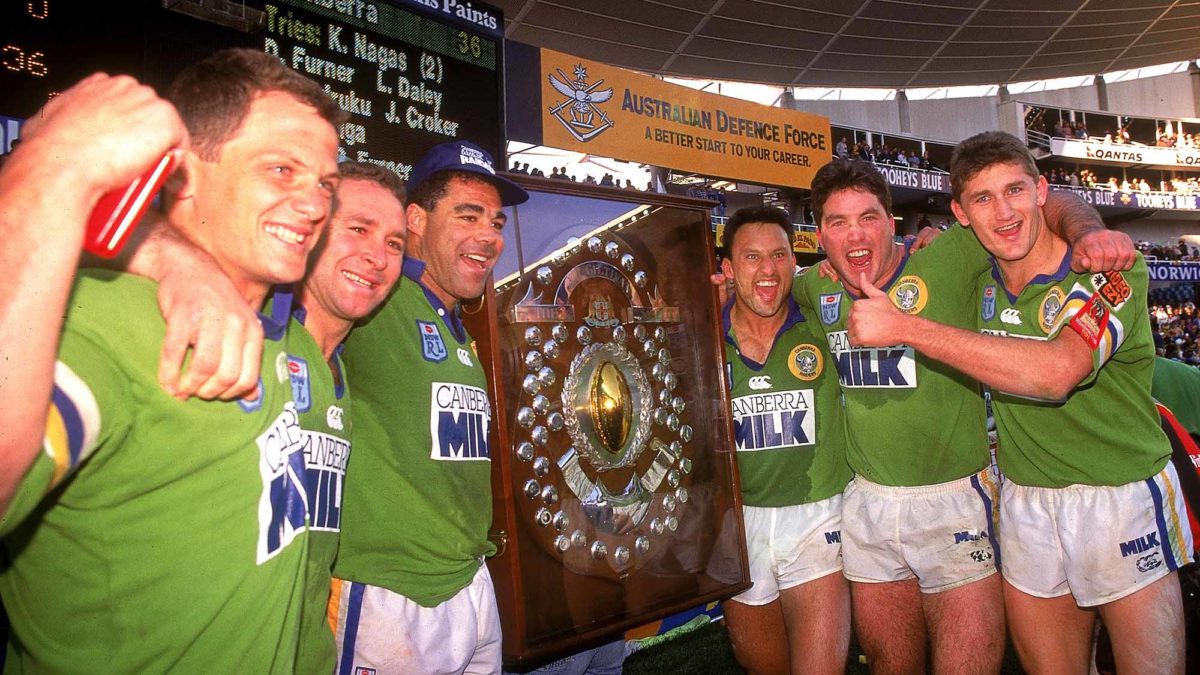
The 1990s were a time unlike any other for rugby league in Australia, definitely the most controversial decade, the likes of which we will hopefully never see again.
Anyone who has listened to the podcast, 60 Songs That Explain The 90s will know how hard it is to sum up such a weird and wonderful period, particularly for those who weren’t around to witness the madness.
It’s the same trying to explain a rugby league decade when the traditionally Sydney-based competition had welcomed in three new interlopers in 1988 and then exploded with four new franchises in 1995.
What followed was even more tumultuous as the game’s civil war nearly tore rugby league apart, culminating in the split season of 1997 before reuniting the following year with a clear mission to shed teams to condense 22 clubs back to 14 by the turn of the century.
Apropo of nothing, as Sheryl Crow would say three decades ago down at Santa Monica Boulevard, here are the 60 Players Who Explain the 90s.
Like Guns and Roses did with Use Your Illusions, we’ve split this epic into two parts.
Today’s article features the players synonymous with the 24 clubs of the 1990s and those who were the best in their position.
Tomorrow’s second edition will be Simply The Rest for all the other memorable footballers who will always be part of the Australian rugby league history books and in one way or the other, are indelibly linked to the 1990s.
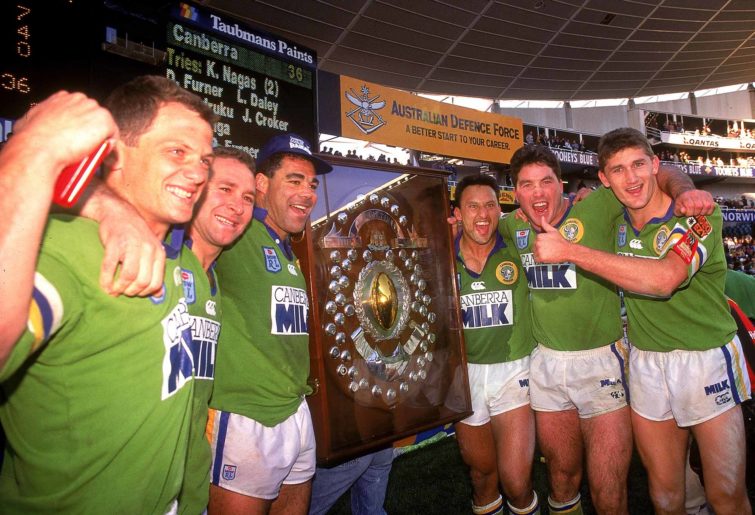
Steve Walters, Ricky Stuart, Mal Meninga, Laurie Daley, Bradley Clyde and Brett Mullins of the Raiders celebrate after winning the 1994 ARL Grand Final between Canberra and Canterbury at the Sydney Football Stadium. (Photo by Getty Images)
The players who explain each club in the 1990s
After the addition of Brisbane, Newcastle and the Gold Coast in 1988, the NSWRL kicked off the decade with 16 teams. Gold Coast went from being Giants to Seagulls and Chargers to out of the league before the decade was out.
The Cowboys, Warriors, Crushers and Reds arrived in 1995 with South Queensland and Perth also dropping out during the rationalisation process. Super League start-up Adelaide spent two seasons in the sun while Melbourne sprung up out of the ruins of Super League in 1998 and created history by lifting the trophy the following year.
Sadly, traditional teams North Sydney, Western Suburbs, Balmain, St George, Illawarra, South Sydney and Manly were kicked out or forced to merge although the Sea Eagles re-emerged a few years later following the Northern Eagles joint venture disaster with the Bears while the Rabbitohs also rose from the dead via a protracted legal battle with the NRL.
The Adelaide Rams: No player sums up the short-lived franchise better than Luke Williamson. A rising star who couldn’t get a start elsewhere, he established himself as a first-grader and would go on to play more than 200 games at the top level after stints at Canberra and Manly. Unfortunately for the Rams, the 1997 and ‘98 season were all they were given as they were easily expendable when officials from the Super League and ARL factions culled teams.
The Auckland Warriors: Stacey Jones made his debut in the Warriors’ foundation season of 1995 and the young halfback immediately became the face of the fledgling franchise, eventually leading them to their first grand final in just their eighth season.

Stacey Jones is a Kiwi rugby league legend. (Photo by Adam Pretty/Getty Images)
The Balmain Tigers: Paul Sironen characterised the diehard Tigers spirit – the longest-lasting member from the late 1980s teams that went agonisingly close to grand final glory, he stuck around until the end of 1998, rejecting lucrative offers from better-performing clubs to finish his 247-game career as a one-club stalwart.
The Brisbane Broncos: Kevin Walters was the glue that held together the star-studded Brisbane teams of the 1990s, partnering Allan Langer in the halves, revving up the forwards and linking out wide to the fleet-footed Steve Renouf, Willie Carne and Wendell Sailor. Walters and winger Michael Hancock were the only Broncos to play in all five grand final wins from 1992-2000.
The Canberra Raiders: Ricky Stuart was the maestro who conducted the orchestra in the national capital. An innovator with his passing and kicking game, he was instrumental in the Green Machine’s premiership successes and if not for his broken leg late in the 1993 season, there may just be another trophy in the club’s cabinet.
The Canterbury Bulldogs: Terry Lamb stayed with the Bulldogs after a mass exodus to Wests early in the decade gutted the joint but he quickly led them back to premiership contention and piloted their 1995 grand final boilover against Manly before retiring the following year.
The Cronulla Sharks: Andrew Ettingshausen was the face of Cronulla who in the second half of his 18-year career, added steely defence to unrivalled attacking flair. Unfortunately for Sharks fans, he, like the club, couldn’t get his hands on a trophy – the closest they came in several ill-fated finals campaigns was the loss to Brisbane in the 1997 Super League decider.
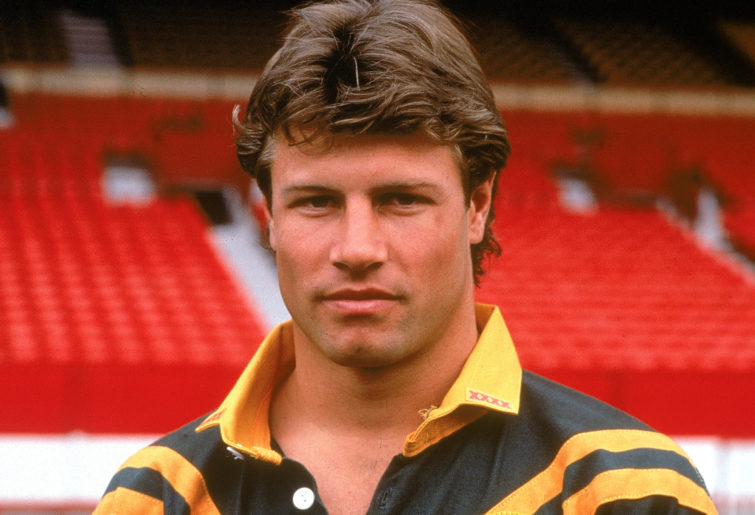
Andrew Ettingshausen in Kangaroos colours on the 1990 Kangaroo tour. (Photo by Getty Images)
The Eastern Suburbs/Sydney City Roosters: Luke Ricketson, a local junior as rare as Rooster’s teeth, epitomised the Roosters’ gradual growth throughout the decade from transit lounge team that would struggle to get 5000 fans to a match at the SFS to a premiership powerhouse that would dominate the early part of the next decade.
The Gold Coast Giants/Seagulls/Chargers: Wally Lewis, past his prime, cranky at the refs, trying to do everything on his own, summed up the Gold Coast’s fortunes in the ’90s. They were always little brother to Brisbane and failed to attract any players in the prime of their career.
The Hunter Mariners: Brett Kimmorley was a young halfback with promise at Newcastle’s Super League bastard son of a franchise which was never going to threaten the Knights’ place in the city’s heart. They had little chance of surviving beyond 1997 but when Newcastle completed their Cinderella grand final win over Manly, it was the final nail in the coffin.
The Illawarra Steelers: Rod Wishart typified the blue-collar work ethic of the Steel City, nothing flashy but effective as part of a bumper crop of local juniors who took the club to its first finals campaign early in the decade but was ultimately brought undone when big-spending Sydney clubs lured several key players up the freeway.
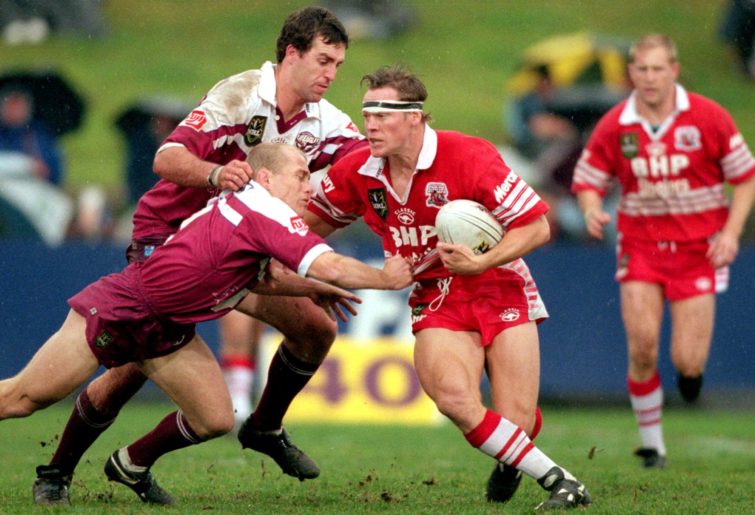
Steelers international Rod Wishart in 1998. (Photo by Getty Images)
The Manly-Warringah Sea Eagles: Terry Hill was brash, in your face and loved to win. That was Manly all over in the 1990s, particularly in the middle when they dominated the competition to make three straight grand finals – a couple of upset defeats either side of their 1996 triumph over St George.
The Melbourne Storm: Matt Geyer was not a name that caught the attention of many footy fans when the Storm first formed but the younger brother of Mark Geyer was a crucial cog in the early Storm machinery for a team that came from all points of the Australian rugby league map. The young winger filled in at five-eighth and goal kicker when his team needed it most as they charged to grand final glory over the even newer St George Illawarra in just their second season.
The Newcastle Knights: Paul Harragon was Newcastle and for many people, “Chief” still is the first name that comes to mind when the topic of conversation turns to the Knights. He made his name individually in the State of Origin arena early in the decade but his finest hour came in 1997 when the veteran prop led Newcastle from the front in their last-second grand final win over Manly. For a city which had been torn apart by an earthquake and job losses, his contribution can never be understated.
The North Queensland Cowboys: Paul Bowman exemplified the reason for the Townsville team coming into the big league in 1995 – a local from Proserpine (only 260km away, just a short trip in North Queensland parlance), he was one of the first long-term building blocks to emerge and fittingly was a part of their first grand final team a decade later.
The North Sydney Bears: Greg Florimo represented NSW and Australia over the course of a career spanning 13 seasons, but would have done anything to get a premiership after bleeding red and black in 285 games, including Norths’ four playoff runs in the ‘90s which ended a game shy of the grand final.
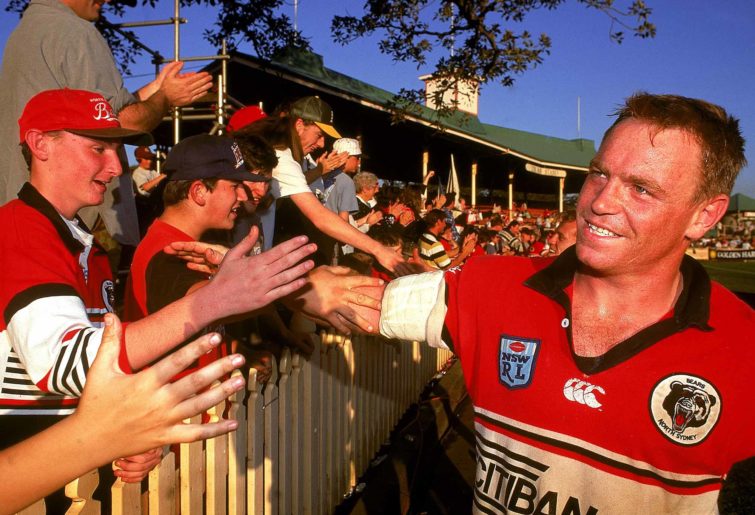
Greg Florimo of the North Sydney Bears (Photo by Getty Images)
The Parramatta Eels: David Woods was a talented centre whose career at Parra in the ‘90s showed plenty of promise but was hampered by injuries. Likewise, the Eels in the decade looked like they’d eventually reach the top but despite going close in the 1998 finals campaign, they were never able to put it all together.
The Penrith Panthers: Greg Alexander was the reason the Chocolate Soldiers became Mountain Men in the late 1980s and he was also the prime mover behind their 1991 grand final win. Rewatch that match and you will see how magnificent he was in his prime – a mix of speed, skill and spontaneity that was the brains behind Penrith’s brawn across the field.
The St George Dragons: Mark Coyne played every season of the 1990s in red and white, an under-rated centre who was part of the back-to-back grand final losses to Brisbane in 1992-93 and captained the team three years later when they went down in the decider to Manly. A neck injury curtailed his final season in ‘99 with the St George Illawarra joint venture which also ended in a loss in the last match of the year.
The St George Illawarra Dragons: Brad Mackay was the only member of the joint venture’s inaugural roster who had played for St George and Illawarra with the veteran forward helping bring together the players from the two clubs to form a team which overcame a slow start to go within a few minutes of a trophy in its foundation season.
The South Queensland Crushers: Mario Fenech was in the twilight of his career when he headed to Brisbane as part of the foundation roster. Unfortunately, he was one of several veteran Crushers who had their career extended a year or two by four teams coming into the premiership at once and the team was never competitive.
The South Sydney Rabbitohs: Mark Carroll gave the Bunnies a hard edge early in the decade and was rewarded with 1990 Kangaroo Tour selection. However, his form dipped and he revived his career at Manly before returning to Redfern for a swansong in 1999.
The Western Reds: Mark Geyer was a difference maker when he was in form but his wild temper and constant judiciary dramas meant he exemplified the Perth team’s hot and cold nature.
The Western Suburbs Magpies: Andrew Willis was a five-eighth who only played 60 matches in a five-year stretch but he was a vital part of Tommy Raudonikis’ battlers who defied the odds to make the 1996 finals, kicking a 48-metre field goal to sink Norths in one of the most amazing moments of the decade.
The ‘90s best players in each position
Brisbane, who won four titles in the 1990s, and Canberra, who lifted the trophy twice from their three grand final appearances, dominated the decade.
The Fullback: Brett Mullins did not play as much representative football as he otherwise would have due to Canberra’s affiliation with Super League but with 95 tries for the decade, he was a potent force from the back at the Raiders.
The Winger: Wendell Sailor was not everyone’s cup of tea with his flashy demeanour on and off the field, but he was pretty much always in the right place at the right time to score out wide for Brisbane, Queensland and Australia.
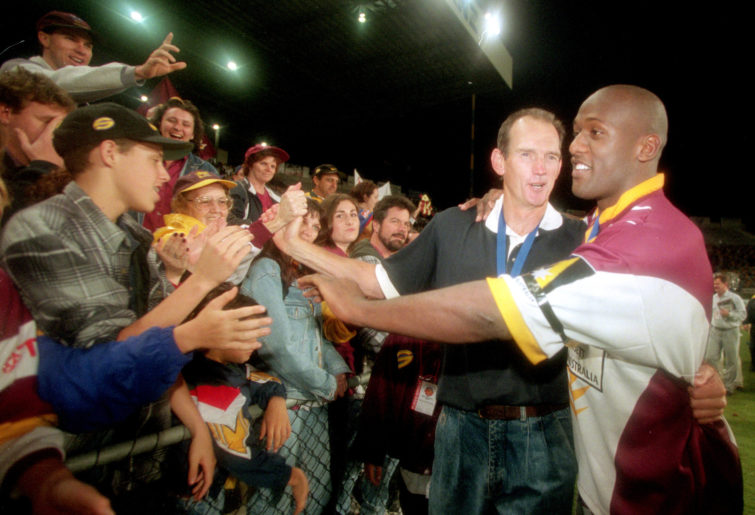
Wayne Bennett celebrates with Wendell Sailor after the Broncos’ Super League grand final victory in 1997.
The Centre: Steve Renouf scored 142 tries in the 1990s, which was 38 more than the next best. When it came to acceleration off the mark, his ability to leave defenders clutching at the spot where he was a second ago was second to none.
The Five-eighth: Laurie Daley was probably the best player of the decade as far as sustained brilliance at club, Origin and Test level. His 1994 grand final performance was a master class and his ability to break open a game with a run a couple of passes off the ruck produced countless wins.
The Halfback: Allan Langer never possessed the skill of his arch rival Ricky Stuart but he made up for it with tenacity and off-the-cuff attacking play to propel Brisbane to four premierships while growing into the leadership role which did not come naturally to him.
The Lock: Bradley Clyde was the standard bearer for back-rowers, picking up from Wayne Pearce in the 1980s, as the player who was able to do a mountain of work in defence but always be the first forward back at the start of a set to take a hit-up. Raiders players from that era almost universally nominate Clyde as their favourite teammate due to his ability to soak up so much work.
The Second-rower: Gorden Tallis was all about quality over quantity. He was the perfect second-rower for the era in that he was mobile but damaging, whether it was his ferocious hits in defence or his barnstorming runs that deservedly earned him the Raging Bull moniker.
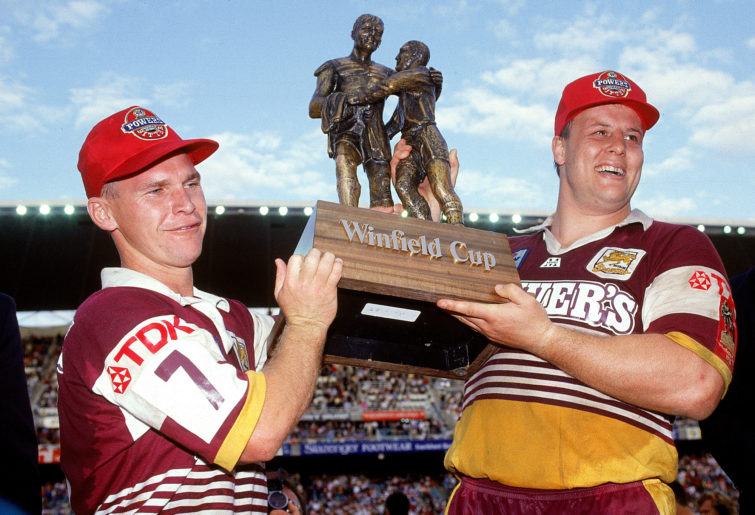
Allan Langer and Glenn Lazarus lift the 1992 Winfield Cup. (Photo by Patrick Riviere/Getty Images)
The Prop: Glenn Lazarus became the first player to win premierships at three clubs in the 1990s when he took his front-row firepower from Canberra to Brisbane and then Melbourne. Despite usually being the biggest forward on the field, he would often punch out 80-minute performances at club and representative level.
The Hooker: Steve Walters transformed the position into a mix of skill and yardage gains, knowing when to send a pass wide to his playmakers or when to take a hit-up, often powering through defenders with a low centre of gravity similar to Storm star Brandon Smith in the current era.
Hat tip to the rugbyleagueproject for being the best source of data for statistical career retrospectives.